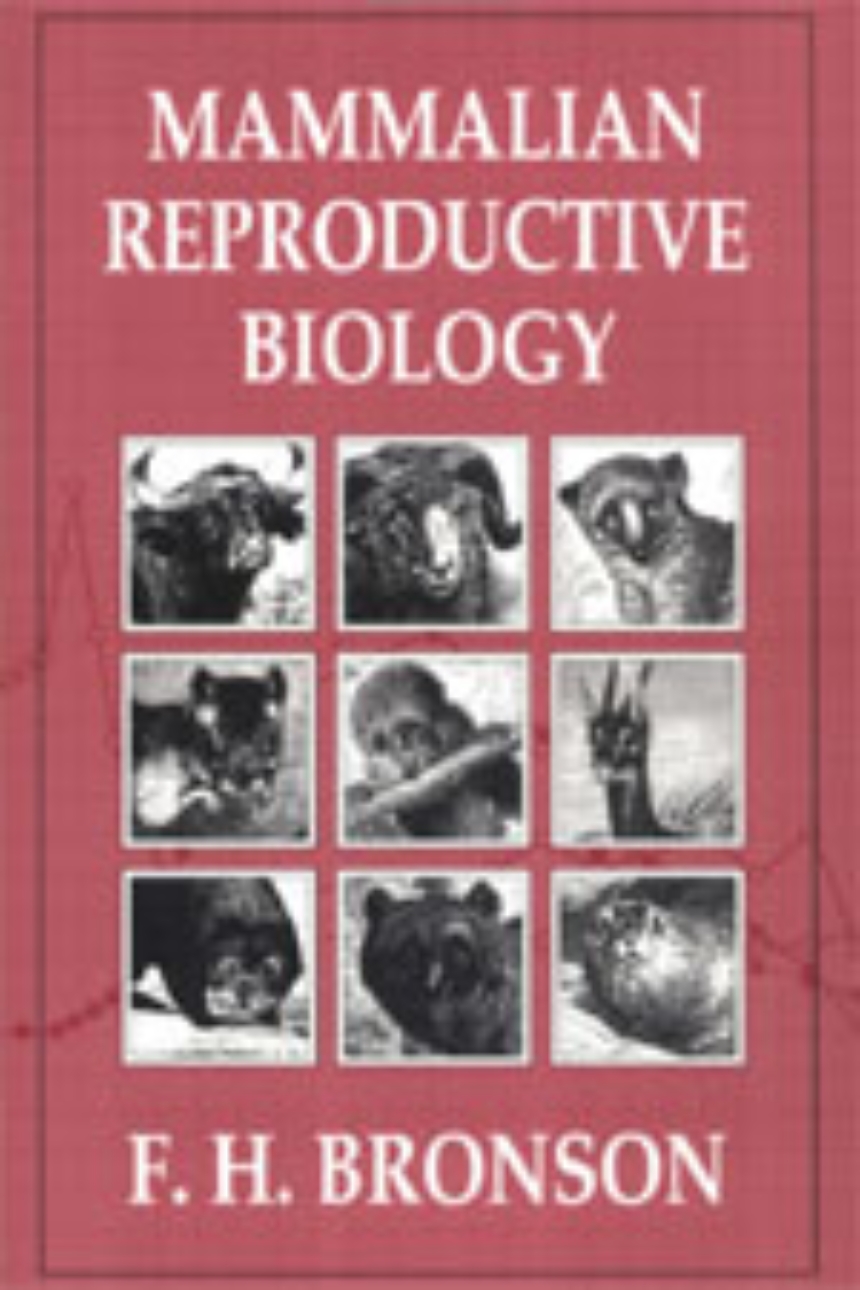Mammalian Reproductive Biology
A unique interdisciplinary overview of the way mammals reproduce, this volume synthesizes research done by laboratory physiologists, behaviorists, population ecologists, and animal breeders. F. H. Bronson has drawn together the disparate literature in these areas to provide students and researchers with a comprehensive and biologically integrated approach to the study of mammalian reproduction.
Each chapter presents a wealth of issues and questions, summarizing the current consensus on interpretations as well as viable alternatives under debate. The book is principally concerned with how environmental factors regulate reproduction. Bronson proposes that a mammal’s reproductive performance routinely reflects simultaneous regulation by several environmental factors that interact in fascinatingly complex ways. Environment is defined broadly, and the chapters give equal weight to ecological and physiological factors when considering how variables such as food availability, ambient temperature, photoperiod, and social cues interact to regulate a mammal’s reproduction. Particular attention is given to seasonal breeding, and a taxonomically arranged chapter underscores the importance of comparative and evolutionary biology to an understanding of mammalian reproduction.
Mammalian Reproductive Biology is a powerful argument for the value and importance of interdisciplinary approaches to research. Its almost 1,500 references constitute the most comprehensive bibliography to date on this topic. Bronson also gives detailed consideration to promising areas for future research. Well organized, carefully planned, and clearly written, this book will become standard reading for scientists concerned with any aspect of mammalian biology.
Each chapter presents a wealth of issues and questions, summarizing the current consensus on interpretations as well as viable alternatives under debate. The book is principally concerned with how environmental factors regulate reproduction. Bronson proposes that a mammal’s reproductive performance routinely reflects simultaneous regulation by several environmental factors that interact in fascinatingly complex ways. Environment is defined broadly, and the chapters give equal weight to ecological and physiological factors when considering how variables such as food availability, ambient temperature, photoperiod, and social cues interact to regulate a mammal’s reproduction. Particular attention is given to seasonal breeding, and a taxonomically arranged chapter underscores the importance of comparative and evolutionary biology to an understanding of mammalian reproduction.
Mammalian Reproductive Biology is a powerful argument for the value and importance of interdisciplinary approaches to research. Its almost 1,500 references constitute the most comprehensive bibliography to date on this topic. Bronson also gives detailed consideration to promising areas for future research. Well organized, carefully planned, and clearly written, this book will become standard reading for scientists concerned with any aspect of mammalian biology.
336 pages | 74 line drawings | 6.00 x 9.00 | © 1990
Biological Sciences: Physiology, Biomechanics, and Morphology
Table of Contents
Preface
1. Mammals: Strategies and Perspectives
Strategies
Perspectives
2. Environmental Regulation: Some General Principles
Environmental Regulation of Fertility Onset
Genes and Environmental Factors
Sex Differences
Population Differences
Natural Selection versus Domestication
Conclusions
3. Seasonal Strategies: Ultimate Factors
The Interaction of Intrinsic and Extrinsic Variation in One Locale
Lattitude and Seasonality
The Tropics
A Purely Energetic Perspective: Small Mammals
Application of an Energetic Perspectives to Larger Mammals
Nutrients and Seasonality
Other Ultimate Factors
Conclusions
4. Food as a Proximate Factor: Neuroendocrine Pathways
The Male’s Reproductive Effort
The Effect of Food Shortage on Male Reproduction
The Estrous Cycle
Food Shortage and the Estrous Cycle
Pregnancy and Lactation
Food Shortage, Pregnancy and Lactation
Energy versus Nutrients
Food Availability as a Proximate Regulator in Wild Populations
Conclusions
5. Ambient Temperature as a Proximate Factor
Temperature, Reproduction, and Genetic Adaptation
The Concept of Stress
Endocrine Pathways: A Speculative Scheme
Conclusions
6. The Predictor Option
The Syrian Hamster
The Sheep
Other Species Studied under Controlled Conditions
Natural Selection and Photoperiodic Cuing
Latitude and Photoperiodic Cuing
Other Predictors
Conclusion
7. Regulation by Social Cues
Social Status, Reproductive Success, and Endocrine Stress
The Priming Pheromone System of the House Mouse
Priming Phenomena in Other Mammals
The Adaptive Significance of Priming Phenomena
Conclusions
8. The Interaction of Cues and Processes
Interacting Cues and Endocrine Responses
Responses in Relation to Phase of Life and Reproductive Cycle
Responses in Relation to Survival Mechanisms
Conclusions
9. A Taxonomic Perspective
Order Marsupialia
Order Insectivora
Order Lagomorpha
Order Rodentia
Order Carnivora
Order Pinnipedia
Order Chiroptera
Order Primates
Order Cetacea
Order Artiodactyla
Conclusions
10. Some Avenues for Future Research
References
Index
1. Mammals: Strategies and Perspectives
Strategies
Perspectives
2. Environmental Regulation: Some General Principles
Environmental Regulation of Fertility Onset
Genes and Environmental Factors
Sex Differences
Population Differences
Natural Selection versus Domestication
Conclusions
3. Seasonal Strategies: Ultimate Factors
The Interaction of Intrinsic and Extrinsic Variation in One Locale
Lattitude and Seasonality
The Tropics
A Purely Energetic Perspective: Small Mammals
Application of an Energetic Perspectives to Larger Mammals
Nutrients and Seasonality
Other Ultimate Factors
Conclusions
4. Food as a Proximate Factor: Neuroendocrine Pathways
The Male’s Reproductive Effort
The Effect of Food Shortage on Male Reproduction
The Estrous Cycle
Food Shortage and the Estrous Cycle
Pregnancy and Lactation
Food Shortage, Pregnancy and Lactation
Energy versus Nutrients
Food Availability as a Proximate Regulator in Wild Populations
Conclusions
5. Ambient Temperature as a Proximate Factor
Temperature, Reproduction, and Genetic Adaptation
The Concept of Stress
Endocrine Pathways: A Speculative Scheme
Conclusions
6. The Predictor Option
The Syrian Hamster
The Sheep
Other Species Studied under Controlled Conditions
Natural Selection and Photoperiodic Cuing
Latitude and Photoperiodic Cuing
Other Predictors
Conclusion
7. Regulation by Social Cues
Social Status, Reproductive Success, and Endocrine Stress
The Priming Pheromone System of the House Mouse
Priming Phenomena in Other Mammals
The Adaptive Significance of Priming Phenomena
Conclusions
8. The Interaction of Cues and Processes
Interacting Cues and Endocrine Responses
Responses in Relation to Phase of Life and Reproductive Cycle
Responses in Relation to Survival Mechanisms
Conclusions
9. A Taxonomic Perspective
Order Marsupialia
Order Insectivora
Order Lagomorpha
Order Rodentia
Order Carnivora
Order Pinnipedia
Order Chiroptera
Order Primates
Order Cetacea
Order Artiodactyla
Conclusions
10. Some Avenues for Future Research
References
Index
